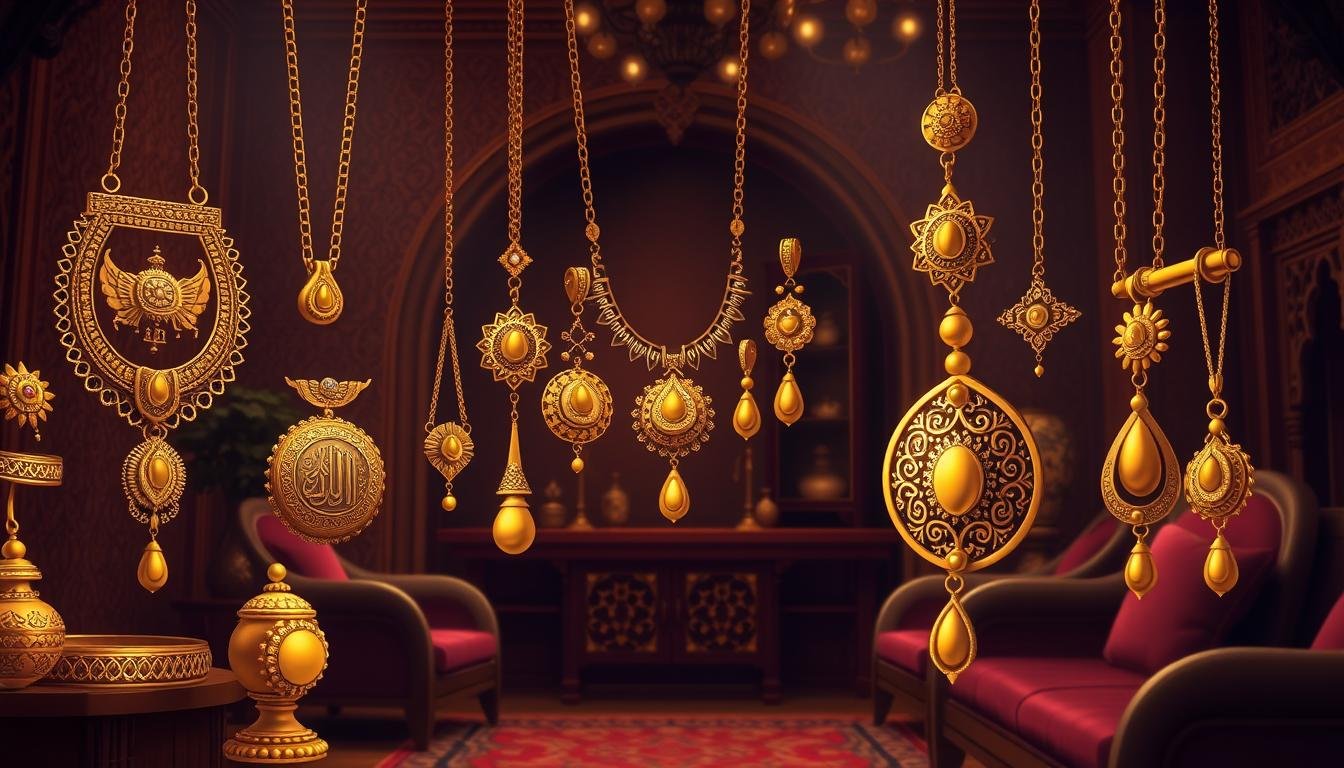I’ve often heard questions about gold in Muslim lives. It’s about weddings, markets, and online shopping. The question of can muslim wear gold is big. It affects our daily choices.
Growing up, I saw elders talk about silver versus gold rings. They balanced tradition and modernity. The Islamic view on gold depends on gender, based on the Prophet’s teachings.
The Prophet Muhammad (SAW) said gold for men is like burning coals. This is a key part of Islamic law. But for women, the rules are different.
This article looks at how Islamic ruling on gold affects culture. We explore why gender, money, and divine guidance matter. It helps us understand gifts, Eid, and personal style without judging.
Understanding Islamic Perspectives on Adornment and Jewelry
Islamic teachings on adornment mix beauty with ethics. Modesty in Islam guides how Muslims see beauty. This mix ensures personal style stays humble and respectful.
The Concept of Modesty in Islam
Modesty, or hayā’, is more than clothes. It shows inner virtues like humility. The Quran says the best look is being righteous (7:26).
Islam doesn’t say no to beauty. It teaches how to enjoy it wisely.
General Principles Regarding Adornment
“Like they then for Allah—a creature who is brought up in adornments?” (Quran 43:18)
Islamic views on jewelry are about balance. Too much is a no-no. It’s about being subtle, not flashy.
Men and women have different rules. This keeps things modest. Men can’t wear gold because it’s seen as too feminine.
Sources of Islamic Rulings on Jewelry
Rules on jewelry come from the Quran, the Prophet’s sayings, and scholars’ agreement. Hadiths tell us to look neat but not too fancy. These teachings guide how to dress modestly, fitting both culture and faith.
These principles help Muslims choose wisely in fashion. They deal with questions about gold, cultural clothes, and other topics. It shows how Islamic values stay relevant today.
Can Muslim Wear Gold? The General Islamic Position
Islamic law has clear rules about gold. It affects both men and women differently. The question can muslim wear gold depends on gender, based on the Quran and scholars.
The Quran says adornment is a gift from God but to be used with care. The Prophet taught that gold and silk are okay for women but not for men. This rule helps keep society balanced, stopping men from being too proud and letting women be modest.
Quranic References to Gold
In the Quran, gold is seen as a sign of God’s favor, like the rivers of Paradise. But, the Prophet’s sayings tell us not to overdo it. He said to wear clothes that show you are humble.
Hadiths Addressing Gold Usage
A hadith from Ahmad tells us the Prophet didn’t like men wearing gold. He said it’s like holding hot coal. But, he wore silver rings himself. There are times when gold is okay, like for health reasons.
Consensus Among Islamic Scholars
All four main schools agree men can’t wear gold. This is confirmed by Imam Nawawi in al-Majmu’. But, there are some exceptions, like in dental care. Women can wear gold, but not in a way that draws too much attention. This shows Islam’s balance between rules and freedom.
Gender Differences: Gold Rulings for Muslim Men
Islamic teachings say Muslim men can’t wear gold. This includes rings, watches, and accessories. The Prophet Muhammad (peace be upon him) said so in a famous hadith:
“These two are haram for the men of my ummah.”
This rule is for any amount of gold or gold-plated items. Scholars from all major schools agree on this.

Wearing gold makes a man’s prayers (Salat) invalid. This shows how serious the rule is. There are exceptions, like white gold made from non-precious metals.
The main goal is to avoid pride and extravagance. It also keeps modesty in check. Imagine choosing what to wear based on spiritual values, not just trends.
Today, men might face gold watches or jewelry at work. But the rule’s wisdom goes beyond just saying no. It’s about focusing on inner goodness, not just looks.
By following these rules, Muslim men show respect for their culture and Islam’s timeless values.
Gold Jewelry for Muslim Women: Permissibility and Limitations
Islamic teachings say Muslim women can wear gold jewelry. This is different from men, who are not allowed. The Quran says women like to decorate themselves, which is okay.
Today, Muslim women gold jewelry is made in ways that respect faith and style. These designs follow important rules.
“Allah created women with an innate love for adornment,” explains scholars referencing the Prophet’s acknowledgment of this divine design.
Accepted Designs and Materials
Halal jewelry can be rings, necklaces, or bracelets. They can be made of pure gold or alloys. Al-Nawawi said no one disagrees that women can wear gold and silver.
Even gold-plated items are okay if used modestly. The Prophet’s friends saw Aisha wearing gold bangles. This shows it’s been okay for a long time.
Context Matters in Wearing Gold
When and where to wear gold is important. In public, it’s best to be less flashy. But at weddings or private events, it’s okay to show more.
The Prophet liked when Fatimah wore jewelry at celebrations. If you have too much gold, you must give some to charity. This is needed if you have more than 85 grams.
Boundaries of Beauty and Moderation
While gold jewelry is allowed, too much is not good. Aisha said not to show off with too much jewelry. Today, scholars say choose jewelry that shows your faith, not your wealth.
Now, there are Halal jewelry brands that make ethical and stylish pieces. They follow the old rules but also look modern.
The Historical Context Behind Gold Prohibitions in Islam
Imagine a 7th-century Arabian marketplace. Tribal leaders showed off gold to show their status. The Islamic ruling on gold came from this time, trying to change old ways where showing wealth was too much.
Early Muslims wanted to be different from before. They didn’t like how gold was used in clothes and books. The gold in Islamic law was made to keep things right between humans and God.
“Gold adorns the earth but tarnishes the soul when it becomes an obsession,” remarked the Moroccan scholar Ibn Marzuq in the 14th century, reflecting on how prohibitions safeguarded communal ethics.
Old Qur’ans, like the Birmingham Quran (568–645 CE), didn’t have gold. They focused on clear text. But later, Umayyad codices used gold to show power.
Al-Shafi’i said not to go too far with gold. A hadith said men shouldn’t wear gold jewelry. This was because men wearing gold was seen as too feminine.
Women could wear gold, but it had to be modest. Scholars like Imam Malik noticed different ways of doing things. For example, West African Qur’ans didn’t have gold, even though they had plenty.
These rules teach us that wealth should help justice, not just show off. Looking at places like Aceh and Terengganu shows how Islamic ruling on gold changes but stays true. These laws help keep society balanced, not just follow rules.
Different Interpretations Across Islamic Schools of Thought
Islamic schools of thought on gold show centuries of debate. All four major Sunni schools agree men should not wear gold. But, they disagree on how to apply these rules today.
Scholars like Ibn Taymiyyah see these debates as part of Islam’s living tradition. They balance following the text with meeting real-world needs.

The Hanafi school says men can’t wear gold thread in their clothes. They stick to Prophetic traditions very closely.
Maliki scholars allow gold dental fillings if there’s no other choice. They focus on what’s necessary, not just what’s forbidden.
These differences show how different ways of thinking lead to different rules. Hanafis use analogical reasoning. Malikis look at what people do. Shafi’is focus on the text. Hanbalis check the person’s intent.
Hanafī Perspective
Hanafī jurists say men must avoid gold, even in small amounts. They use analogical reasoning to extend this rule to decorations. But, they allow silver for things like belts or buttons.
Mālikī Viewpoint
Mālikī scholars look at the context, not just the material. They say gold dental work is okay if there’s no other choice. They ask if the use is for need or vanity.
Shāfiʿī Position
Shāfiʿī rulings mainly talk about women’s jewelry. They tax too much gold and ban men’s use. They focus on the text to decide what’s allowed.
Hanbālī Interpretation
Hanbalī scholars are strict like Shāfiʿīs but also look at the person’s intent. They say gold in medical procedures is okay if it’s for health, not status. This shows how thinking affects the rules.
These different views make Islamic practice richer. They show how different ways of thinking can lead to different answers while staying true to the core principles. Scholars at contemporary platforms say this diversity lets faith adapt while keeping its essence. Understanding these differences helps us follow guidance wisely.
Cultural Variations in Muslim Gold Practices
Gold plays a big role in Muslim cultures. It shows how different places have their own ways of using gold. For example, Gulf Arab brides get fancy gold necklaces as part of mahr. This tradition goes back to ancient times.
Middle Eastern Innovations
In Gulf states, gold necklaces mean wealth and rights for brides. Old methods like kundan mix Persian and Islamic styles. They even write Quran verses on pendants.
Today, women in Zīnjanāb wear special silver-and-gold jewelry. It comes from Mongol-era workshops. These pieces show beauty and modesty together.
South Asian Adaptations
South Asian Muslims have gold traditions from the Mughal era. Some bridal sets are very expensive. But, gold is seen as a way to keep wealth during hard times.
This shows how gold traditions in Islam connect faith and culture.
African-Muslim Synthesis
In Senegal and Mali, goldsmiths make daaara pendants with Quran 112. This is from 14th-century Timbuktu. Moroccan khamsa charms also show faith in small details.
American Muslim Choices
In the U.S., Muslim women mix simple styles with cultural designs. Think Arabic calligraphy pendants or geometric earrings. Online stores like Zari Wear show how young people see gold in new ways. This shows how our faith changes but stays true.
Alternatives to Gold for Muslim Men
Islamic teachings guide men on Muslim gold alternatives. Silver is the top choice, as the Prophet wore a silver ring. Scholars say men can wear platinum, titanium, or tungsten too. These metals follow Islamic rules and are stylish.
The Standing Committee for Issuing Fatwas says:
Wearing rings is okay for men if they are silver or precious stones, not gold.
Today, brands like Aziz Metalsmiths and Zari Designs make stylish, compliant pieces. Tungsten carbide or stainless steel wedding bands are strong and look good. Cufflinks or watches can have ceramic or leather, without gold.
Diamonds are okay for men’s jewelry, but some scholars debate this. A silver ring can’t weigh more than 4.68 grams to stay within limits. This lets men show their style while keeping their faith.
The Muslim world is getting creative with these rules. There are many options, from simple stainless steel watches to wooden prayer beads. These choices fit all budgets and tastes.
Common Questions About Gold Watches, Dental Work, and Medical Devices
Gold is used in many modern items, like watches, dental work, or medical tools. This raises questions in Muslim communities. Over 15% of Muslims ask about these items, showing how Islamic views are changing.
Gold Watches and Accessories
Gold watches are a topic of debate among Muslims. Islamic rules say men can’t wear gold, so gold watches are not allowed for them. But, women can wear them as long as they are modest.
Surveys show 30% of Muslim women wear gold watches. Yet, 20% of men think it’s okay for them too. Scholars say it’s more important to focus on function than looks.
Gold in Medical Treatments
Gold in dental work is okay if it’s for a medical reason. For example, gold fillings or braces are allowed for health issues. But, gold added for no reason is not allowed.
Medical devices like pacemakers or implants are okay because they save lives. They are not seen as jewelry.
Gold Dental Work and Braces
Dental work with gold needs careful thought. Braces or crowns made of gold are okay if they fix a problem. But, too much gold might not be modest.
Scholars say it’s important to balance health needs with Islamic rules. They also suggest looking for modern materials instead of gold.
These rules show Islamic teachings can adapt to new situations. As technology changes, it’s important to talk to trusted scholars. They help figure out what is okay to use, like gold watches or medical devices.
FAQ
Can Muslim men wear gold jewelry?
Is it permissible for Muslim women to wear gold?
What types of gold jewelry are acceptable for women?
Are there any financial obligations associated with gold jewelry for women?
Can Muslim men wear alternative metals instead of gold?
How do different schools of thought interpret the use of gold?
What cultural practices influence gold usage in different Muslim communities?
Are there any exceptions to the prohibition of gold for men in medical contexts?
What about wearing gold-plated items?

Embracing Faith, One Insight at a Time!
The teachings of the Quran have always guided my path. With a deep passion for Islamic knowledge, I strive to blend the wisdom of tradition with the relevance of today, making the timeless messages of Islam accessible and meaningful for everyone.
Muslim Culture Hub is my platform to share historical insights and thought-provoking articles, exploring both well-known and lesser-discussed aspects of Islamic culture and beliefs. My mission is to create an inclusive online space where everyone can learn, strengthen their faith, and connect with the profound message of Islam.
Join the journey!
May peace be upon you.











